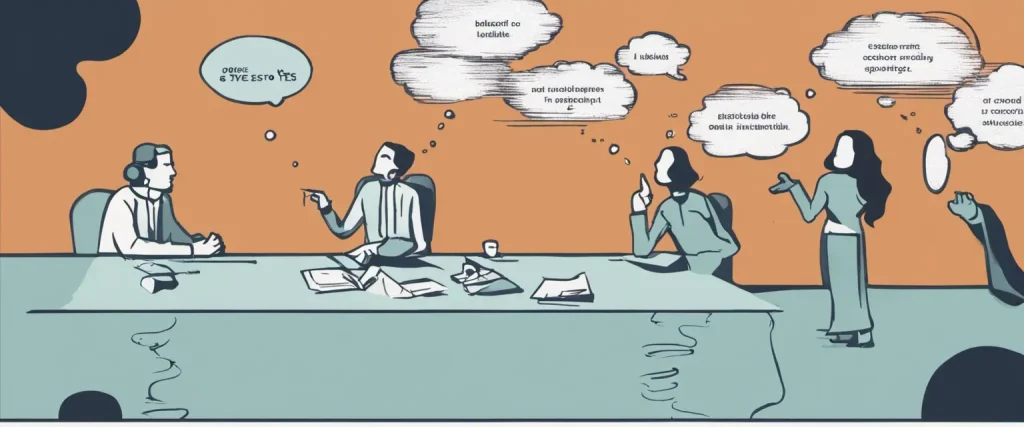Getting to Yes by Roger Fisher is a groundbreaking book that revolutionizes the art of negotiation. In this globally recognized classic, Fisher and his co-authors present a methodical approach to achieve mutually beneficial agreements, focusing on principled negotiation rather than traditional positional bargaining. Through their extensive research and practical insights, the authors provide readers with a powerful set of tools to overcome adversaries in any negotiation scenario, leading to win-win outcomes. Now let’s delve deeper into the expertise of Roger Fisher, one of the world’s leading experts in negotiation and conflict resolution.
Chapter 1: The Problem
Chapter 1 of “Getting to Yes” by Roger Fisher introduces the central thesis of the book – the method of principled negotiation. The chapter highlights the flaws in traditional negotiation methods and emphasizes the need for a more effective approach.
Fisher begins by stating that negotiation is a pervasive aspect of our lives, occurring in both personal and professional contexts. However, he argues that most people approach negotiation with a positional mindset, rooted in the desire to defend their own interests rather than engaging in a collaborative process. This often leads to a win-lose mentality, where each party focuses on extracting concessions from the other.
The author criticizes this adversarial method, suggesting it encourages manipulation, stubbornness, and hostility. He presents two specific problems with this approach: it often results in an outcome far from ideal for both parties and damages the long-term relationship.
Fisher proposes principled negotiation as a more constructive alternative. He describes it as a method that focuses on reaching a result that is fair, satisfies both parties’ interests, and strengthens the relationship between them. It involves four essential steps: separating the people from the problem, focusing on interests rather than positions, generating multiple options to satisfy both parties, and using objective criteria to determine the best solution.
The chapter concludes by highlighting the positive impact of principled negotiation, leading to creative agreements, fair outcomes, and improved relationships. Fisher sets the stage for the subsequent chapters, where he elaborates on the key principles and techniques of this approach, providing readers with a framework to resolve conflicts effectively and achieve mutually beneficial agreements.
Chapter 2: Separate the People from the Problem
Chapter 2 of the book “Getting to Yes” by Roger Fisher is titled “Separate the People from the Problem.” This chapter emphasizes the importance of effectively dealing with conflicts by recognizing that people and their emotions are distinct from the substance of the problem at hand.
Fisher explains that a negotiation often becomes more challenging when the people involved become personally tied to the issue or when emotions cloud objective judgment. He argues that it is essential to separate the people from the problem to focus on constructive dialogue and find mutually beneficial solutions.
The chapter introduces two main challenges in dealing with the human aspect of negotiations. The first is the role of perception, as people tend to perceive situations differently based on their background, experiences, and emotions. Fisher suggests that acknowledging these differing perceptions and understanding the motives and concerns of all parties involved can lead to better problem-solving.
The second challenge lies in managing emotions. Fisher acknowledges that emotions can play a significant role in negotiations, often leading to misunderstanding and breakdowns in communication. He highlights the importance of addressing emotions directly, while still recognizing the need to focus on the underlying interests of both parties.
To separate the people from the problem effectively, Fisher offers several strategies. These include listening actively to understand the other party’s perspective, expressing emotions constructively to create a conducive environment for open discussion, and avoiding negative assumptions about the intentions or behavior of others.
In summary, Chapter 2 of “Getting to Yes” emphasizes the importance of separating the people involved from the substantive issues at hand in negotiations. By recognizing and addressing differing perceptions and managing emotions constructively, parties can work together to find mutually beneficial solutions.
Chapter 3: Focus on Interests, Not Positions
Chapter 3 of “Getting to Yes” by Roger Fisher emphasizes the importance of focusing on interests rather than positions in negotiations. The chapter starts by challenging the commonly accepted view that negotiation involves arguing over positions. Instead, the authors argue that successful negotiation requires understanding the underlying interests and needs of both parties involved.
Fisher highlights the dangers of getting stuck on positions, as this can lead to a win-lose mentality where one side’s gain is perceived as the other side’s loss. Taking a position-based approach often leads to stubbornness, a lack of creativity, and an unhealthy focus on winning at all costs. In contrast, the authors advocate for a problem-solving approach that focuses on the interests driving the negotiation.
To identify interests, Fisher suggests asking ‘why’ questions to uncover the motivations and desires behind each party’s position. By understanding the underlying interests, negotiators can find common ground and generate more creative solutions that meet each party’s needs. This approach encourages collaboration and helps build mutually beneficial outcomes.
Additionally, the authors introduce the notion of inventing options for mutual gain. They argue that by brainstorming and exploring various possibilities, negotiators can identify win-win solutions that address both parties’ interests. This emphasis on joint problem-solving promotes trust, collaboration, and more sustainable agreements.
The chapter concludes by highlighting the importance of focusing on interests throughout the negotiation process. It encourages negotiators to separate the people from the problem, understand each party’s perspective, and actively seek mutually beneficial outcomes.
In summary, Chapter 3 of “Getting to Yes” emphasizes the need to shift from a position-based approach to one that focuses on the underlying interests of both parties. By doing so, negotiators can foster collaboration, generate creative solutions, and achieve agreements that address the true needs of all involved.
Chapter 4: Invent Options for Mutual Gain

Chapter 4 of “Getting to Yes” by Roger Fisher discusses the importance of inventing options for mutual gain in the negotiation process. The chapter emphasizes that successful negotiation does not solely focus on determining a fair solution but requires exploring various possibilities to create value for all parties involved.
The author highlights the common approach of positional bargaining, where negotiators adopt rigid positions and attempt to compromise to reach an agreement. However, Fisher argues that this approach often limits creativity and fails to address the underlying interests of both parties. Instead, the book advocates for a more innovative and collaborative method known as principled negotiation.
Inventive options play a crucial role in principled negotiation as they allow negotiators to expand the range of possible solutions. Fisher suggests that parties should engage in brainstorming sessions, searching for multiple alternatives that could potentially benefit both sides. By focusing on interests rather than positions, negotiators can identify shared objectives and generate creative options.
The chapter introduces four obstacles that typically hinder the development of inventive options. These obstacles include premature judgment, searching for a single answer, the assumption of limited resources, and the belief that “solving their problem is their problem.” Fisher provides insights into overcoming these obstacles, urging negotiators to tolerate ambiguity in the early stages of brainstorming, remain open to various solutions, explore the potential for collaboration, and separate the process of inventing options from deciding which option to pursue.
In summary, Chapter 4 of “Getting to Yes” emphasizes the significance of inventing options for mutual gain in negotiations. By expanding the range of possibilities and focusing on shared interests, negotiators can create value and achieve more satisfactory outcomes for all parties involved.
Chapter 5: Insist on Using Objective Criteria
Chapter 5 of “Getting to Yes” by Roger Fisher titled “Insist on Using Objective Criteria” highlights the importance of employing objective standards in negotiations. The chapter reveals that objective criteria are crucial to reaching mutually beneficial agreements and overcoming the pitfalls of positional bargaining.
Fisher explains that relying solely on subjective positions can lead to a deadlock, where each party becomes fixated on their own demands. To shift from positional bargaining to principled negotiation, he argues that objective criteria can serve as a guide in determining fair standards and ensuring a more reasonable outcome.
The chapter introduces four criteria that can help parties reach agreements based on objective standards. First, Fisher suggests relying on market value. By studying the market prices of similar goods or services, negotiators can establish a benchmark for fair terms and prices.
Second, he emphasizes the importance of using scientific data and expert opinions. This involves sourcing information from impartial experts to inform discussions and decisions objectively. These insights can prove influential in validating claims and finding a common ground.
Third, Fisher discusses the relevance of past practice as a reference point. By understanding previous agreements made in similar situations, negotiators can establish precedent as a means of determining what is fair and reasonable.
Lastly, the chapter introduces the concept of mutually agreed-upon standards. Fisher suggests creating standards collaboratively with the other party, emphasizing the importance of considering both perspectives to ensure the outcome is acceptable to all involved.
Overall, the chapter emphasizes the importance of utilizing objective criteria to guide negotiations. By focusing on market value, scientific data, past practice, and mutually agreed-upon standards, negotiators can shift the discussions from purely positional arguments to principled solutions that meet both parties’ interests.
Chapter 6: Determine a BATNA (Best Alternative To a Negotiated Agreement)
Chapter 6 of “Getting to Yes” by Roger Fisher explores the concept of BATNA (Best Alternative To a Negotiated Agreement), which is considered as the alternative course of action that parties can resort to if a negotiation fails to reach a satisfactory agreement. This chapter emphasizes the significance of determining and assessing our BATNA before entering into any negotiation.
Fisher highlights that understanding our BATNA allows us to make informed decisions during negotiations, thus avoiding rash and unfavorable agreements. He emphasizes that having a strong BATNA positively influences our negotiation power, enhancing our ability to set limits and walk away if the agreement does not meet our objectives.
The chapter suggests that a BATNA should not be confused with our desired outcome, as it represents the course of action that we can take if negotiations are unsuccessful. It could range from seeking alternative partners, exploring other opportunities, or pursuing an alternative solution that satisfies our interests.
Fisher provides practical steps for determining a BATNA. First, we need to invent a list of possible alternatives we can consider in case the negotiation fails. The key is to identify and develop the most promising and realistic alternatives. Then, we must evaluate each alternative based on criteria such as feasibility, cost, time, and potential to meet our interests effectively.
The author emphasizes that a strong BATNA provides confidence and leverage in negotiations, allowing us to negotiate with a clear mind and objective criteria. It enables people to avoid getting locked into unfavorable agreements and facilitates productive negotiations where both parties can explore options to create mutually beneficial outcomes.
In summary, Chapter 6 of “Getting to Yes” highlights the importance of determining a BATNA before entering into negotiations. By understanding our alternatives, evaluating their feasibility, and considering our best interests, we can negotiate from a position of strength and make informed decisions that create favorable outcomes.
Chapter 7: Shape the Process
Chapter 7 of “Getting to Yes” by Roger Fisher is titled “Shape the Process” and focuses on the importance of crafting an effective negotiation process. The chapter starts by explaining that shaping the process is a crucial step towards reaching a mutually agreeable outcome.
The authors highlight the significance of establishing ground rules that promote fairness, efficiency, and cooperation during negotiations. They encourage creating a process where both parties feel listened to and respected, reducing the chances of aggressive tactics and increasing the likelihood of a constructive dialogue.
One effective method to shape the process is to establish a neutral third party to facilitate the negotiation. This mediator, impartial to both parties, can help structure the discussion, moderate communication, manage emotions, and ensure that all perspectives are heard. Fisher emphasizes that the mediator should focus on helping both sides reach a satisfying outcome rather than taking sides.
Another technique discussed is the use of objective criteria. By employing standards that are independent of either party’s preferences, negotiations can be more rational and fair. Objective criteria often include market value, precedent, or expert opinion. By relying on these external benchmarks, both sides can prevent bias and emotions from overshadowing their decision-making process.
The authors also stress the importance of separating the exploratory phase of negotiation from the decision-making phase. During exploration, parties can brainstorm creative options without commitment. By separating the two stages, negotiators avoid the pressure to constantly defend and conform to a narrow set of positions.
Overall, Chapter 7 emphasizes that shaping the negotiation process is crucial for fostering a collaborative atmosphere that facilitates productive discussions and leads to mutually beneficial agreements. By establishing ground rules, neutral mediators, and objective criteria, negotiators can increase the chances of reaching an agreement that satisfies both parties.

Chapter 8: Conclusion and Final Thoughts
In Chapter 8: Conclusion and Final Thoughts of the book Getting to Yes by Roger Fisher, the authors bring together the key concepts and principles discussed throughout the previous chapters and provide a final summary and reflection on the negotiation process.
The chapter begins by emphasizing the importance of principled negotiation, which involves focusing on interests rather than positions and seeking mutually beneficial solutions. The authors emphasize that negotiation is not about winning or losing, but rather about reaching agreements that satisfy both parties’ needs and goals. They stress the value of open and honest communication, active listening, and creative problem-solving in achieving successful negotiations.
Furthermore, the authors highlight the significance of options and alternatives in negotiations. By exploring multiple possibilities and alternatives, negotiators can expand the range of potential solutions and find options that are more beneficial for both parties. They reiterate that a negotiator should always have a clear BATNA (Best Alternative to a Negotiated Agreement) to avoid being pressured into accepting unfavorable agreements.
The authors also address the issue of power in negotiations. They suggest that instead of focusing on an imbalance of power, negotiators should utilize their own sources of power such as their expertise, relationships, or objective criteria. By building trust and establishing a mutually respectful environment, negotiators can minimize power dynamics and work towards collaborative solutions.
Finally, the chapter concludes by reiterating the key takeaways from the book and emphasizing the importance of preparation, understanding the other party’s interests, and maintaining a collaborative mindset in negotiations. The authors encourage readers to apply the principles and strategies discussed in the book to various negotiation scenarios and remind them that negotiation skills can be learned and improved through practice and experience.
Overall, Chapter 8 serves as a comprehensive summary and reminder of the key principles of principled negotiation, providing a strong conclusion to the book Getting to Yes.
After Reading
In conclusion, “Getting to Yes” by Roger Fisher is a groundbreaking guide to negotiation strategies and principles based on mutual interests, rather than adversarial tactics. Fisher advocates for a collaborative approach that fosters creativity, empathy, and fairness to reach mutually satisfactory agreements. Through practical examples and step-by-step techniques, the book offers valuable insights on effective communication, separating people from the problem, and developing win-win solutions. “Getting to Yes” is an essential resource for anyone seeking to improve their negotiation skills and cultivate positive relationships in both personal and professional domains.
1. Difficult Conversations” by Douglas Stone, Bruce Patton, and Sheila Heen
This book is a must-read for anyone seeking to improve their communication skills and navigate challenging conversations successfully. It provides practical and insightful tools to handle conflict, manage emotions, and find common ground in difficult situations.
2. “Negotiating the Impossible” by Deepak Malhotra
Building upon the principles of negotiation, Malhotra offers an innovative approach to resolving seemingly impossible disputes. By sharing fascinating real-life examples and practical strategies, this book equips readers with the necessary skills to overcome impasses and achieve win-win outcomes.
3. Crucial Conversations” by Kerry Patterson, Joseph Grenny, Ron McMillan, and Al Switzler
Following the same vein as Difficult Conversations, this book delves into the art of effectively communicating in crucial moments. It provides readers with practical tips, tools, and frameworks to navigate emotional conversations, improve relationships, and make lasting agreements.
4. “Getting Past No” by William Ury
Although not mentioned in the initial prompt, this book is a fantastic companion to the recommended reads. Ury explores strategies to handle tough negotiation situations, such as dealing with difficult people and overcoming resistance. His insightful approach empowers readers to transform impasses into opportunities for mutual agreement.
5. Influence” by Robert Cialdini
To round off the selection, “Influence” offers valuable insights into the psychology behind persuasion and influencing others. By understanding the underlying principles, readers can enhance their negotiation skills and become more effective communicators in a variety of contexts.
These five books collectively provide a comprehensive toolkit for mastering difficult conversations, negotiation, and persuasion. Each one offers unique perspectives and practical techniques that will undoubtedly empower readers to handle complex interpersonal dynamics and achieve successful outcomes.



